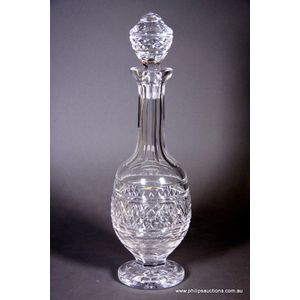Colonial Inlaid Sewing Table by William Norrie
You must be a subscriber, and be logged in to view price and dealer details.
Subscribe Now to view actual auction price for this item
When you subscribe, you have the option of setting the currency in which to display prices to $Au, $US, $NZ or Stg.
- Scroll Legs - are in the form of an elongated scroll or 's' shape, from which the cabriole leg also derived. Scroll legs, however, are usually rather more substantial and are frequently found supporting side tables and hall tables throughout much of the 19th century. As a rule, the back legs of such tables intended to remain against the wall were flat and rectangular.
- Column - An architectural feature sometimes used for decorative effect and sometimes as part of the supporting construction. Columns should generally taper slightly towards the top. They may be plain or decorated with carving, fluting or reeding. Columns may be fully rounded or, more commonly, half-rounded and attached with glue, screws or pins to the outer stiles of doors, or the facing uprights on cabinets and bureaux.
- Stretcher - A horizontal rail which connects the legs of stools, chairs, tables and stands, to provide stabilisation of the legs. A stretcher table is any table with a stretcher base. The term is usually applied to substantial farmhouse tables, although many cabinetmaker's pieces, such as sofa tables, also have turned stretchers.
- Inlay - Decorative patterns inserted into the main body of a piece of furniture, generally in wood of contrasting colour and grain, though brass, ivory, ebony, shell and sometimes horn have been used. Inlay may consist of a panel of well figured timber inset into a cabinet door front, geometric patterns, or complex and stylized designs of flowers, swags of foliage, fruits and other motifs. As a general rule, in pieces where the carcase is constructed in the solid, the inlay is relatively simple such as stringing, cross banding and herringbone banding. Where more elaborate and decorative work was required veneer was used. Inlay has been fashionable from at least the latter half of the 17th century, when a variety of elaborate forms were developed
- Parquetry - Parquetry is inlay laid in geometric patterns, the contrast being achieved by the opposing angles of the grain and veneers. The herringbone pattern is the most commonly used in flooring, but this is almost never seen in furniture - the patterns used are more complex and unlike flooring, can include several different varieties of timber.
- Attributed - A cataloguing term where the item in the opinion of the cataloguers, is a of the period of the artist, craftsman or designer, and which probably in whole or part is the work of that person.
This item has been included into following indexes:
- New Zealand, furniture - tables 63
- Norrie, William (New Zealand) - furniture and decorative items 38
- tables, purpose or type - sewing and work 363
-
tables, small, period or style
- Australian 98
- William IV 68
Visually similar items

Pavel Ovchinnikov, c.1880 Russian tea caddy bulbous shape, the body with red enamel work and silver dragonfly, spider and leaf motifs with a spider web background, the domed pull off cover with a silver leaf and a silver bug, gilt interior, weight 335 gram

French mother of pearl inlay mandolin

A fine Waterford decanter, circa 1974, 'Castletown' design introduced 1972, the elegant long necked pedestal decanter of ovoid form with an acorn shaped stopper, with a diamond patterned frieze between horizontal cut rings, slice cut to the neck, the stopp

Antique Chinese carved ivory page turner handle with carved scene of figures and pavilion to one side & carved pattern decoration verso. (As inspected: age crack to body and small section missing from handle corner top left.)length L27 cm This it
